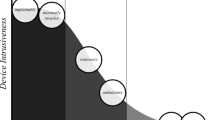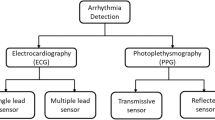Abstract
Electrocardiogram (ECG) signal utilized by Clinicians to extract very useful information about the functional status of the heart. Of particular interest systems designed for monitoring people outdoor and detecting abnormalities on the real time. However, there are far from achieving the ideal of being able to perform adequately real time remote cardiac health monitoring in practical life. That is due to problematical challenges. In this paper we discuss all these issues, furthermore our intimations and propositions to relief such concerns are stated.
Access this chapter
Tax calculation will be finalised at checkout
Purchases are for personal use only
Preview
Unable to display preview. Download preview PDF.
Similar content being viewed by others
References
Dale Dubin, M.D.: Rapid interpretation of EKG’s, 6th edn. Cover publishing co. (2000)
Rajendra, U., Sankaranarayanan, M., Nayak, J., Xiang, C., Tamura, T.: Automatic Identification of cardiac health using modeling techniques: a comparative study. Inf. Science. 178, 457–4582 (2008)
Rodrigues, J., Goni, A., Illarramendi, A.: Real time classification of ECG on a PDA. IEEE Trans. On IT in B.med., 23–33 (2005)
Goldberger, A.L.: Electrocardiography: A Simplified Approach. Elsevier, Amsterdam (2006)
Kligfield, P.: value and limitation of 12-lead ECG monitoring. clinical window, Datex, Ohmeda (2001)
Mark, R., Moody, G.: MIT-BIH Arrhythmia data base directory. Massachusetts Institute of Technology, Cambridge (1988)
Clifford, G., Azuaje, F., McSharrg, P.: Advanced methods and tools for ECG data analysis. Artech house (2006)
Chritove, I., Herrero, G., Krasteva, V., Jekova, I., Gotchev, A., Egiazarian, K.: Comparative study of morphological and time frequancy ECG descriptors for heartbeat classification. Medical engineering and physics 28, 876–887 (2006)
Sörnmo, L., Laguna, P.: Bioelectrical Signal Processing in Cardiac and Neurological Applications. Elsevier, Amsterdam (2005)
de Bie, J.: P-wave trending: A valuable tool for documenting supraventricular arrhythmias and AV conduction disturbances. IEEE, 511–514 (1991)
Millet, J., Pkrez, M., Joseph, G., Mocholi, A., Chorro, J.: Previous identification of QRS Onset and Offset is not essential for classifying QRS complex in a single lead. Com. In: Cardiology, vol. 24, pp. 299–302 (1997)
Moody, G., Mark, R.: QRS Morphology Representation and Noise Estimation using the Karhunen-Loève Transform. IEEE, Comp. in Card, 269–272 (1989)
Lagerholm, M., Peterson, C., Braccini, G., Edenbrandt, L., Sörnmo, L.: Clustering ECG complex using Hermite Functions and selforganizing maps. Trans. on B. med. Eng. 47, 838–848 (2000)
Senhadii, L., Carrault, G., Bellanger, J., Passariello, G.: Comparing wavelet transforms for recognizing cardiac patterns. IEEE, Eng. Med. & Bio., 167–173 (1995)
Herrero, G., Gotchev, A., Christov, I., Egiazarian, K.: Heartbeat classification using independent component analysis and matching Pursuits. In: ICASSP, pp. 725–728. IEEE, Los Alamitos (2005)
Christov, I., Bortolan, G.: Ranking of pattern recognition parameters for premature ventricular contractions classification by neural networks. Phys. Measure 25, 1281–1290 (2004)
Chazal, P., Dwyer, M., Reilly, R.: Automatic classification of heartbeats using ECG morphology and heartbeat interval features. IEEE Trans. Biomed. Eng. 51, 1196–1206 (2004)
Jekova, I., Bortolan, G., Christov, I.: Assessment and comparison of different methods for heartbeat classification. Med. Eng. Phys. 30, 248–257 (2008)
Osowski, S., Linh, T.: ECG beat recognition using fuzzy hybrid neural network. IEEE Trans. Biomed. Eng. 48, 1265–1271 (2001)
Palreddy, H., Tompkins, W.: A patient-adaptable ECG beat classifier using a mixture of experts approach. Trans. on B. med. Eng. 44, 891–900 (1997)
Bortolan, G., Jekova, I., Christov, I.: Comparison of four methods for premature ventricular contractions and normal beats clustering. Comp. Card. 30, 921–924 (2005)
Bashir, M.E.A., Akasha, M., Lee, D.G., Yi, M., Ryu, K.H., Bae, E.J., Cho, M., Yoo, C.: Nested Ensemble Technique for Excellence Real Time Cardiac Health Monitoring. BioComp., lasvegas, USA (2010)
Bemaid, A., Bouhouch, N., Bouhouch, R., Fellat, R., Amri, R.: Classification of ECG Patterns Using Fuzzy Rules Derived from ID3-Induced Decision Trees. In: NAFIPS, pp. 34–38. IEEE, Los Alamitos (1998)
Kampouraki, A., Manis, G., Nikou, C.: Heartbeat time series classification with support vector machines. Eng. in Med. and Bio. Sc. 13, 512–518 (2009)
Yang, T., Devine, B., Macfarlane, P.: Artificial neural networks for the diagnosis of atrial fibrillation. Med. Biol. Eng. Comp. 32, 615–619 (1994)
Birman, K.: Rule-Based Learning for More Accurate ECG Analysis. Tran. on Puttern analysis and Mach. Int. 4, 369–380 (1982)
Rajendra, U., Subbann, P., Iyengar, S., Raod, A., Dua, S.: Classification of heart rate data using artificial neural network and fuzzy equivalence relation. Pattern Recognition 36, 61–68 (2003)
Lee, D., Shon, Ho Ryu, K., Cho, M., Bae, J.: Clinica Database Based on Various Factors of Cardiovascular Diseases. In: International workshop on aware computing, Japan, pp. 604–609 (2009)
Ho Ryu, K., Kim, W., Lee, H.: A Data mining approach and framework of intelligent Diagnosis system for Coronary Artery disease Predication. In: KSES, Japan, pp. 33–34 (2008)
Author information
Authors and Affiliations
Editor information
Editors and Affiliations
Rights and permissions
Copyright information
© 2010 Springer-Verlag Berlin Heidelberg
About this paper
Cite this paper
Bashir, M.E.A. et al. (2010). Highlighting the Current Issues with Pride Suggestions for Improving the Performance of Real Time Cardiac Health Monitoring. In: Khuri, S., Lhotská, L., Pisanti, N. (eds) Information Technology in Bio- and Medical Informatics, ITBAM 2010. ITBAM 2010. Lecture Notes in Computer Science, vol 6266. Springer, Berlin, Heidelberg. https://doi.org/10.1007/978-3-642-15020-3_21
Download citation
DOI: https://doi.org/10.1007/978-3-642-15020-3_21
Publisher Name: Springer, Berlin, Heidelberg
Print ISBN: 978-3-642-15019-7
Online ISBN: 978-3-642-15020-3
eBook Packages: Computer ScienceComputer Science (R0)




